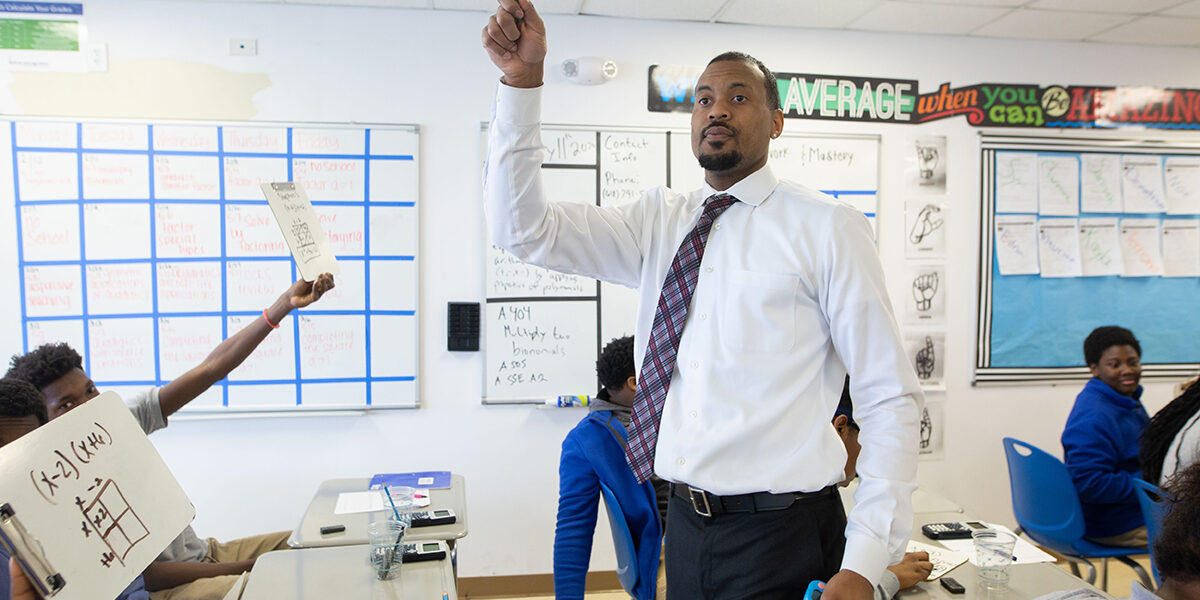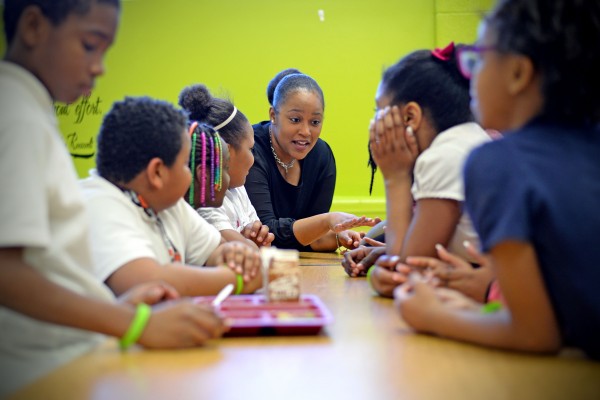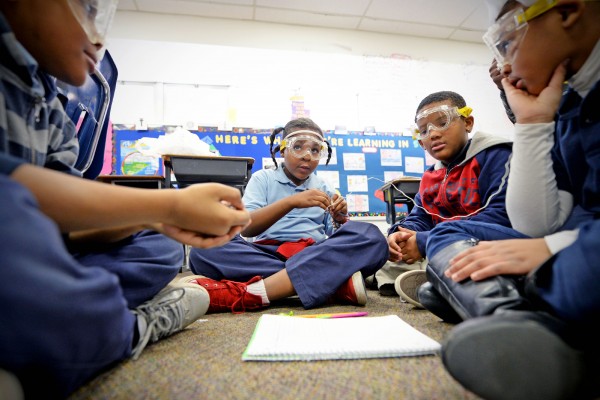The clock is ticking.
KIPP: St. Louis algebra teacher Josh Humphrey has 45 minutes to deliver his lesson on geometric sequences to his ninth-grade class — what they are, why they matter and how they differ from their mathematical cousin, the arithmetic sequence.
He moves methodically, first telling students the definition and then showing them an example of an investment that climbs from $1,800 to $2,016 to $2,057 to $2,304.
“Now, using the common ratio, find the next term,” Humphrey says. “I’ll give y’all a minute. Let’s go.”
Humphrey sets a timer and takes a lap around his classroom.
“Yep, you’ve got it, John,” he tells one student. “Keep going, Jaden. You’re on the right track,” he tells another.
The alarm goes off, and Humphrey makes his way to the front of the class, nudging a sleepy student along the way.
“This is a very real situation, y’all,” Humphrey tells the class. “You put your money in the bank, and every month it increases by 12%. That’s a lot. This is a very simple example of what I went to school for — finance.”
“Why aren’t you doing that?” one student asks.
“Because I wanted to teach you all,” Humphrey says. “For real.”
The students crack up, but Humphrey isn’t joking. Unfulfilled by his high-stress, high-paying job as a loan officer, Humphrey has chosen the high-stress, low-paying field of education. And he couldn’t be happier.
“Okay, back to work,” says Humphrey, wasting no time. Some of his students here are a year or more behind grade level, and he is determined to get them up to speed. “Now working with your partner, determine if these sequences are geometric or arithmetic. One minute on the clock.”
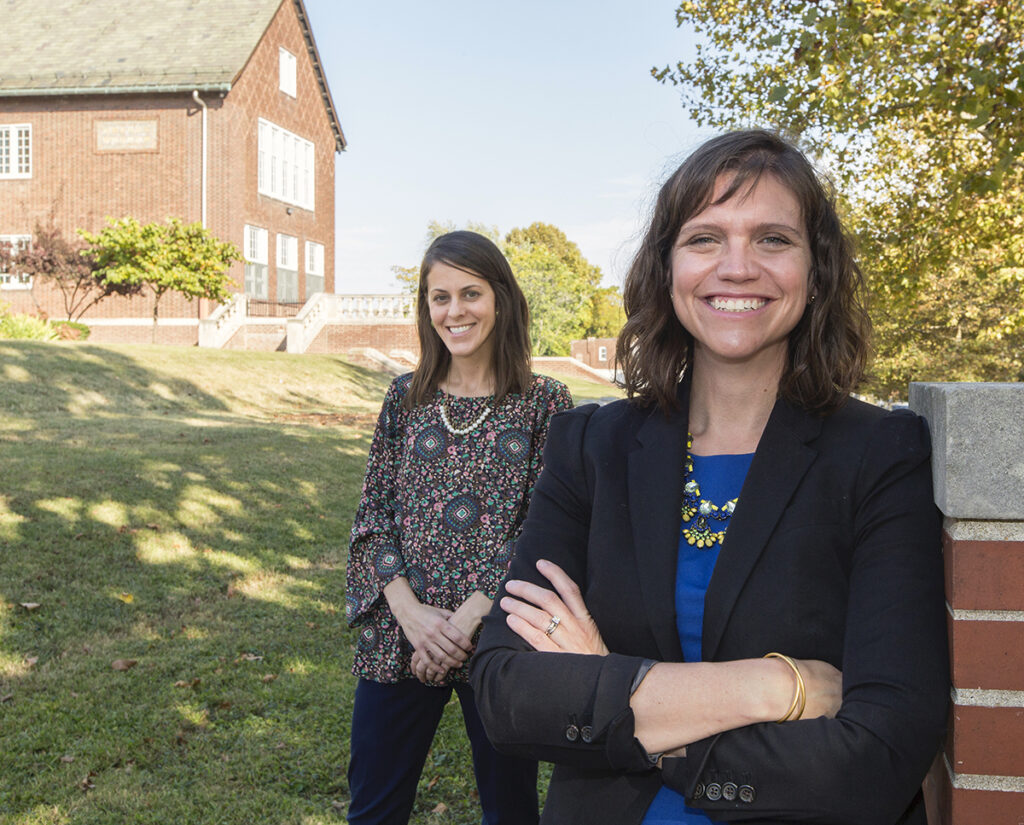
Proving the possible
Humphrey is a member of the first cohort of the St. Louis Teacher Residency, a unique initiative designed to address two of the biggest challenges in our local schools — teacher turnover and teacher quality. Launched in 2018 by two Washington University in St. Louis alumnae, Laura Vilines, AB ’06, and Anne Lamb, AB ’06, in partnerships with Washington University’s University College, Institute for School Partnership and Department of Education in Arts & Sciences, the program gives teachers the skills to support high-needs students and build effective lessons while deepening their own knowledge of the subjects they teach. Residents work at St. Louis Public Schools and KIPP: St. Louis as well as Premier Charter School, City Garden Montessori School and Northside Community School.
Humphrey spent one year as an apprentice teacher at KIPP, learning from the school’s top math instructor, followed by another year as a paid lead teacher in his own classroom. During that time, he worked toward his master of arts degree in teaching and learning from University College. Fully licensed, Humphrey will stay at KIPP for at least two more years. That’s great news to Nicole Niewald, co-leader at KIPP High School, for two reasons. One, Humphrey is a successful black man in a school that is nearly all-black and low-income.
“He proves the possible,” Niewald said.
And two, he’s really good at teaching math. That’s a big deal because all high schools, high-needs or not, struggle to hire effective math instructors.
“Josh has evolved over time to be this mathematical thinker who makes math concepts exciting for students,” Niewald said. “He pushes kids to think about the why.”
There is so much to learn
Before founding the St. Louis Teacher Residency, Vilines served as chief academic officer at STEM Preparatory Academy, a charter school network located in Nashville, Tennessee. No part of the job was more important — or more difficult — than hiring and retaining effective teachers. The applicants were compassionate and credentialed. But Vilines’ own experience as a teacher and her research as a PhD student at Vanderbilt University taught her that educators need more than good intentions to thrive in a high-needs classroom.
“We knew teachers from some programs would be good classroom managers, but man, they would need a lot of support in planning and pedagogy,” Vilines recalled. “Teachers from other programs would have great pedagogical content knowledge but not the skills to build a strong classroom community. Our students couldn’t afford to wait for teachers to master these skills. They needed good teachers now.”
At that time, a new type of teacher training program started to emerge — the teacher residency. Unlike most teaching programs where aspiring teachers take classes for two years and then work as student teachers, residents gain immediate experience, putting lessons learned during their coursework immediately into practice. Vilines was intrigued by the model’s promise to improve student outcomes, increase the ranks of educators of color and bring stability to schools desperate to retain talented teachers.
By the time Vilines left her job to return to St. Louis with husband Seth Stratton, AB ’06, for his residency at Barnes-Jewish Hospital, Nashville had two residencies. St. Louis had none. The need here was apparent — almost half of all St. Louis Public School teachers leave the district within five years. And only one-third of its students, largely Black and low-income, score proficient in math and English. The reasons why are many and complex, but researchers agree poverty and trauma often lead to poorer academic outcomes. They also agree good teaching makes a difference and that Black educators, in particular, hold higher expectations for their Black students.
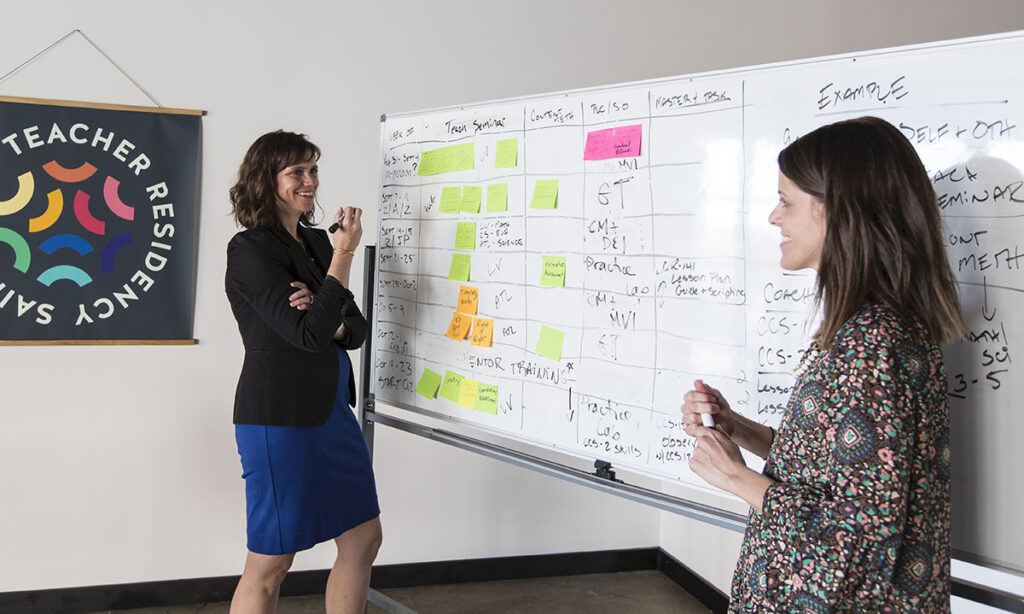
Vilines recruited former classmate Anne Lamb, also serendipitously returning to St. Louis, to help her build the residency. The two were roommates during their time as Teach for America instructors; Lamb taught at Normandy School District and Vilines at the failed Imagine Schools charter network.
“Laura and I took different career paths but share a common belief — every student deserves an effective teacher,” said Lamb, who researched education evaluation as a Harvard doctoral student and as a policy analyst at the U.S. Department of Education. “There is a pervasive acceptance that if you are a student in a low-income community, it’s OK if you don’t do well because you have so many challenges. We wanted to change that narrative.”
Vilines and Lamb agreed the residency must be affordable, selective and academically rigorous, with a focus on recruiting second-career students and students of color. They found an enthusiastic partner in Pat Matthews, associate dean at University College, the university’s professional and continuing education division.
“Our missions are really the same — to expand opportunities for our community,” said Matthews, who served as adviser to Humphrey and other residents. “Economic advancement and equity in St. Louis must be built on the foundation of educational advancement. That doesn’t start with college. It starts with primary and secondary education.”
Washington University’s Institute for School Partnership (ISP) also plays a key role, working with the residency to develop the program’s curriculum and providing instruction specialists. ISP has delivered professional development to thousands of teachers through its MySci curriculum, STEMpact Teacher Quality Institute and other programs.
“We thought of this teacher residency the same way you think of a medical residency, preparing the residents for the reality of the urban classroom while providing a mentor and a place where they could discuss theory and practice,” said Vicki May, ISP executive director and a leading expert in inquiry-based learning techniques. “To know subject areas, to know how to motivate children, to know the culturally relevant pedagogy… There is so much to learn.”
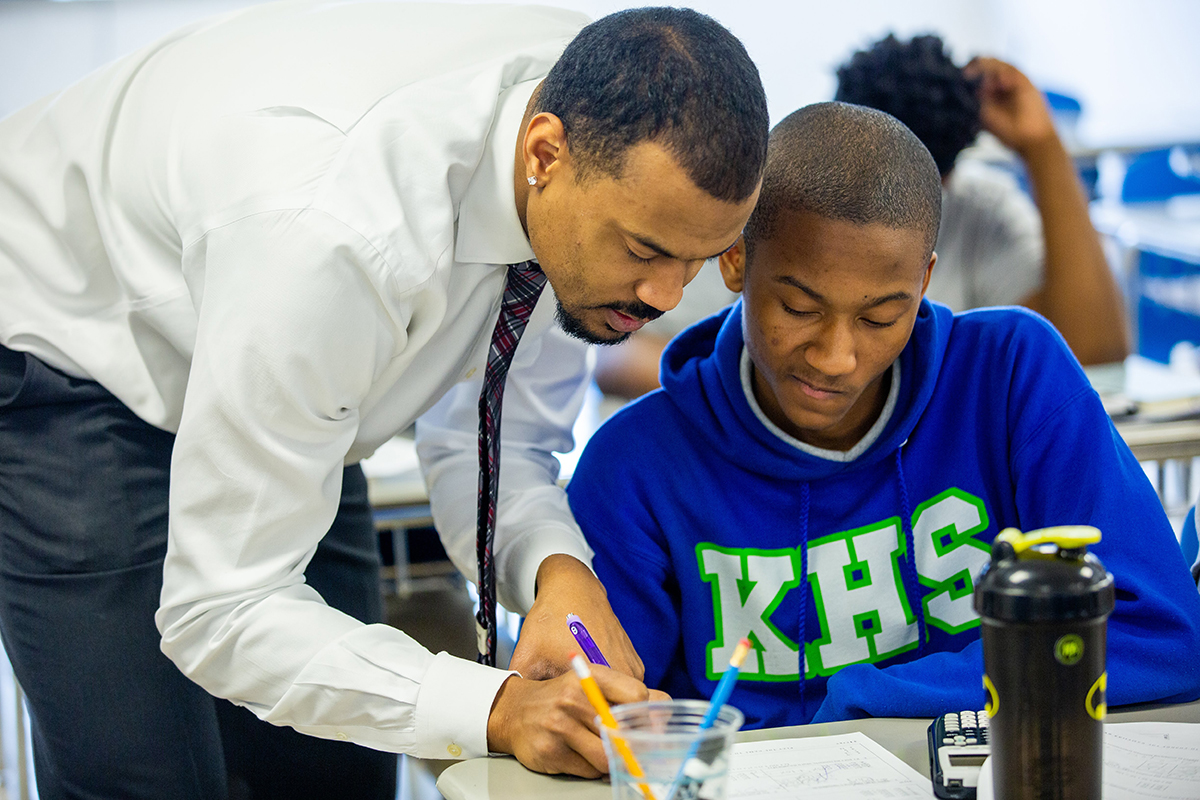
Playing the game to change the game
Indeed, as Humphrey’s geometric sequence lesson illustrates. He left nothing to chance, including placing canisters of sharpened pencils on each desk so students don’t waste time searching for their own and strategically organizing student seating.
“My highest achieving students are at the corners so, when I do my laps, I can see quickly how they’re doing,” Humphrey explained. “If they don’t understand, then it’s a safe bet the other students don’t either.”
The night before, Humphrey practiced his lesson and prepared a “do now,” a quick assignment students complete at the start of class to get in the right headspace. And that morning, he observed his mentor, teacher and instructional coach Steven Dickherber, deliver the same lesson to his class.
You have to pay attention to what you say, how you say it, where you stand in a classroom, how to give a correction, how to narrate the positive. I didn’t realize how much was involved in teaching until I got into the residency
Josh Humphrey, MATL ’20
During his own class, Humphrey deployed many of the teaching techniques he learned as a first-year resident. He reeled that sleepy student into the discussion by asking him to explain how he found the common ratio. That’s known as “cold calling.” His running commentary as students worked to find the next term is an example of “narrating the positive,” a strategy that reinforces classroom expectations and motivates students. And when Humphrey asked students to work together, a.k.a. “turn and talk,” he was offering them the chance to formulate and articulate their ideas.
These students were focused, but that’s not always the case. Later that same day, he relied on another best practice — a private conversation — to help a student who refused to work.
“In this job, you will be called names and have kids act out,” Humphrey said. “That’s when I lean on my relationship with students. If you have a good relationship, then you can have that conversation that gets them back on track. With her, she was having some issues at home. You never know what’s going on, so it’s important to listen and let them know, ‘I want you to do better. I want you to be successful.’”
That night Humphrey took home a milk crate filled with “exit tickets,” assessments students take at the end of class, to grade. The solid results let Humphrey know he’s doing a good job, a conclusion reaffirmed at the end of the school year when his students outperformed most of their peers across the KIPP network. Humphrey then got started on his own homework for his class, “Advanced Teaching Methods: Secondary Mathematics.” Next it was time to watch a video — of himself teaching.
“I’m an athlete, so I’m always looking for ways to improve,” said Humphrey, who went to college on a basketball scholarship. “Sometimes I see there is too much teacher talk and not enough student discourse. You have to pay attention to what you say, how you say it, where you stand in a classroom, how to give a correction, how to narrate the positive. I didn’t realize how much was involved in teaching until I got into the residency.”
And that was before a deadly pandemic. Humphrey has adapted, consulting with his KIPP colleagues and fellow residents to learn best practices in online teaching. Doug Lemov, author of the international bestseller Teach Like a Champion, even highlighted one of Humphrey’s asynchronous lessons on his popular blog.
Humphrey also has been a source of comfort to his students, many of whom were rocked by the killings of George Floyd and Breonna Taylor. He reminds them that a degree is a powerful weapon in the fight against systemic racism and injustice.
“That’s part of being a great teacher too, letting them know they have the power to effect change,” Humphrey said. “I tell them, ‘You all need to play the game to change the game.’”
